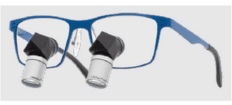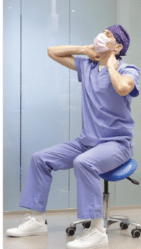Clinical Insights: Preventing Pain in Practice: Tips For A Healthier Work Life
By encouraging an ideal working posture, LumaDent’s ErgoPrism loupes help eliminate the musculoskeletal stress of daily practice.
Due to the nature of their work, dental professionals are at high risk of experiencing musculoskeletal pain and discomfort. From hunching over patients for hours to holding awkward positions, the physical demands of dentistry can take a toll.1 However, with the right approach and tools, it’s possible to prevent pain and promote a healthier work life.
As a practitioner, I experienced multiple areas of work-related pain, and these injuries led me to explore clinical solutions — including therapeutic yoga and proper ergonomics — to reduce pain and the risk of disability and early retirement. I now serve as an ergonomic assessment specialist, and my passion is to help dental professionals find an individualized approach to pain prevention and management.
STRETCHING AND STRENGTHENING
Stretching and strengthening exercises are essential for any clinician who wishes to prevent musculoskeletal disorders. Regular stretching can help reduce tension in muscles, increase blood flow, and improve flexibility.2 While many exercises can be done chairside, oral health professionals should consider incorporating yoga or pilates into their routine outside of work.
Strengthening exercises can improve stability and posture, which are both key to proper ergonomics. Finding a balanced approach to these exercises can help prevent, reduce, and alleviate the risk of injury and pain.

MAINTAIN A NEUTRAL POSTURE
Adopting an ergonomic approach is essential to promoting health and well-being.3 Proper posture, a key element of ergonomics, involves maintaining correct alignment during the delivery of care.4 A neutral position involves keeping the head, neck and back in proper alignment, with the shoulders relaxed and arms at the sides. The feet should be flat on the ground, and the hips should be higher than the knees. In addition, practitioners should ensure the operatory is set up to reduce unnecessary movements and awkward positions. Similarly, patients should be positioned in a manner that allows ergonomic care. Collectively, these steps will improve clinical efficiency and productivity, while also supporting physical well-being.
ERGONOMIC LOUPES AND SEATING
Choosing ergonomic tools can further reduce the physical strain of dentistry. For example, saddle stools are designed to improve posture and reduce back pain, as a well-fitted saddle stool promotes a forward tilt of the pelvis, which keeps the spine in a neutral position.5
Ergonomic loupes also support a neutral, upright position during care.6 Unlike traditional loupes that require practitioners to look down and tilt the head and body forward, LumaDent’s ErgoPrism loupes allow providers to maintain a neutral posture, which significantly reduces the load on the muscles and joints in the back and neck (Figure 1). Another benefit is that a neutral posture positively affects breathing and circulation, which are crucial for pain prevention and stress management alike.
ErgoPrism loupes represent a lightweight and truly ergonomic solution that’s designed to facilitate a long and healthy career. LumaDent offers multiple magnification levels, as well as an innovative headlight that rotates in all directions to illuminate hard-to-access areas with less strain on the body.
Preventing pain and discomfort in dentistry requires a combination of stretching, strengthening, and the use of ergonomic tools, such as magnification. By taking steps to prevent pain and discomfort, dentists can work comfortably and efficiently while providing the best possible care for their patients.
LumaDent
775-829-4488
REFERENCES
- Kumar M, Pai KM, Vineetha R. Occupation-related musculoskeletal disorders among dental professionals. Med Pharm Rep. 2020;93:405–409.
- Seguin-Fowler R, Graham M, Ward J, Eldridge G, Sriram U, Fine D. Feasibility of a yoga intervention to decrease pain in older women: a randomized controlled pilot study. BMC Geriatr. 2020;20:400.
- U.S. Occupational Safety and Health Administration. Ergonomics. Available at: https://www.osha.gov/ergonomics. Accessed March 30, 2023.
- Cramer H, Mehling WE, Saha FJ, Dobos G, Lauche R. Postural awareness and its relation to pain: validation of an innovative instrument measuring awareness of body posture in patients with chronic pain. BMC Musculoskelet Disord. 2018;19:109.
- Gouvêa GR, Vieira WA, Paranhos LR, Bernardino ÍM, Bulgareli JV, Pereira AC. Assessment of the ergonomic risk from saddle and conventional seats in dentistry: a systematic review and meta-analysis. PLoS One. 2018;13:e0208900.
- Plessas A, Bernardes Delgado M. The role of ergonomic saddle seats and magnification loupes in the prevention of musculoskeletal disorders. A systematic review. Int J Dent Hyg. 2018;16:430–440.
From Decisions in Dentistry. May 2023;9(5):22.


